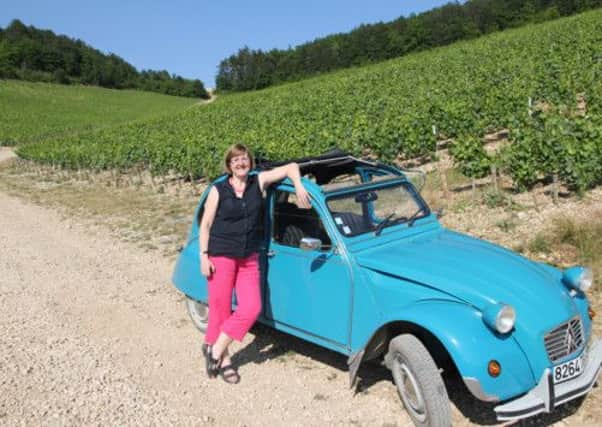Discovering a vin of steel


My guide, Eric, was attempting to show me all the main vineyards and soil structures in Chablis in just half a day. But as I noticed during my backwards slide down the hill, the soil type changes with the slope. ‘Kimmeridgian’ is the term used to describe the particular mix of limestone and marl packed with clumps of tiny fossilised oyster shells which forms the main topsoil. Some areas gleam almost white with stones while other areas are light brown and friable.
Soil type is regarded as the key to good Chablis. The area is carefully mapped out so you know exactly what quality of wine can come from each vineyard – Grand Cru, Premier Cru or just basic Chablis. There are even areas designated Petit Chablis which are usually on a completely different soil known as Portlandian limestone, or sometimes on the tops and on the northern side of hills where the vines don’t get the same levels of sunshine as south-facing slopes.
Advertisement
Hide AdAdvertisement
Hide AdThe best area sits overlooking the town, in an arc of hillside, facing south west, gathering up as much sunshine as possible. This collection of seven Grands Crus: Preuses, Bougros, Vaudesir, Grenouilles, Valmur, Les Clos and Blanchots is highly prized yet even between these individual plots there are differences in soil and taste which some locals can tell apart.
Chablis is one of the most well-known wines of the world. Maybe it has something to do with its purity of flavour and the way it cleanly accompanies all kinds of foods but there is always the possibility that it has something to do with the simplicity of its name. There was a time when the name was hijacked by Australia and California to describe almost any dry white wine, but all that has changed. Chablis can only come from this region north of Burgundy and it can only be made from the Chardonnay grape. But even if you have given up on Chardonnay, the chances are that you won’t have given up on Chablis. Its racy, clean style, usually without any sense of oak on the palate, is completely different from almost any other Chardonnay you can buy.
There are just 3,200 hectares of Chablis, just one-tenth of the area there used to be in the late 1800s. Phylloxera swept through the region at that time, and alongside the destruction of vineyards came destruction of the market as the new railways brought cheaper wine to Paris from the south. But the region is coherent now, clearly occupying the best slopes and producing steely, mineral-edged wines that can be enjoyed fresh and young or aged to complexity and finesse.
One of the key producers of the region is the co-operative, La Chablisienne which handles 25 per cent of the whole region’s production. Dynamic, modern and capable of keeping individual parcels of grapes separate, it not only sells wine under its own name but it provides own-label wines to many supermarkets. Marks & Spencer has sourced its Chablis from this co-op for decades, providing one of the most consistent, lean, almost-crunchy wines edged with notes of oatmeal biscuits on the shelves. It can age too. The current 2010 vintage which won a Silver medal in the International Wine Challenge is terrific and has the weight and body to develop for another couple of years.
Advertisement
Hide AdAdvertisement
Hide AdBut while the co-op is vital to the region there are some growers who are moving to bottling and selling their own wines. This is a massive step, requiring investment in a winery and in marketing but for Didier Robin, the eighth generation of his family in the wine business, this seemed like the obvious choice. Now with a sparkling new winery, and control over 30 hectares of vines across some of the southern stretch of hills he is making wines that show his own style and individuality. His Chablis 2012 had just gone into bottle when I visited and it was still tight and unyielding, but the 2011 had filled out, with bright, crisp, lemony fruit and the steely backbone of good Chablis that will take another couple of years to bend. His Vosgros Premier Cru 2011 was vibrant with acidity and almost salty with minerality, yet floral overall while Vaucoupin 2009 was deep, complex and long. Find the wines of Didier Robin under the family Maison Louis Robin name at Gauntley Wine in Nottingham (0115 911 0555).
Cyril Testut at Domaine Testut has also changed the way he works, bottling the best part of his production to sell while the rest is sold off in bulk to bigger name producers. With a philosophy of ‘lutte raisonnée’ which means that he uses the absolute minimum vine treatments, his 11 hectares of vines produce fine quality wines with minerality to the fore. House of Townend (01482 638888) in Hull stocks his Chablis 2011 (£12.99) which is well worth a taste.
Other wines to look out for include those from William Fèvre, a long-established Chablis producer which has enough production to supply Majestic Wine Warehouse, yet still maintain high standards. Try Chablis Maladière 2011 (£13.99 on multibuy) for its citrus fruit and bone-dry finish or trade up to Premier Cru Chablis Vaillons 2011 (£30) which is produced from biodynamically-farmed vines. It does seem to have deeper intensity and grip.
Petit Chablis is where the bargains are to be found. Try Jean de Chaudenay 2012 Petit Chablis (£9.99 Waitrose) which delivers crisp apple and citrus flavours and enough minerally crunch to accompany a good Saturday lunchtime salad.